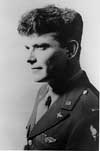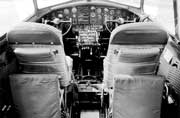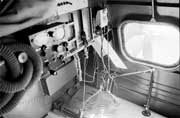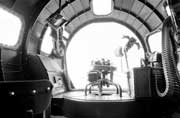As part of the research into this story, we got a copy of the book Wrong Place! Wrong Time! by George C. Kuhl. The subtitle is The 305th Bomb Group & 2nd Schweinfurt Raid, October 14, 1943. So this book was written about the same raid as described by Maurice, but the 305th Bomb Group was in the 1st Bombardment Division of the Eighth Bomber Command, while Maurice's Bomb Group (the 94th) was in the 3rd Bombardment Division. According to this book, each of these Divisions started more than 140 B-17 bombers to Germany on that ‘Second Schweinfurt’ raid. Much of the following was taken from Kuhl's book or another titled Black Thursday by M. Caiden.
|
2nd Schweinfurt: Mission Overview by Due to mechanical, personnel and weather problems, 56 flights were aborted, so that each division actually had 130 planes enroute the target. However, the two Divisions took different routes to the target, and were scheduled to drop their bombs within 20 minutes of each other. The statistics of aircraft returning showed that the 1st Division lost 45 planes, while the 3rd Division lost 15, for a total of 60. The author gives his analysis and opinion of the reasons for the heavy losses incurred by the 1st Division, and especially the 305th Bomb Group of that division, which dispatched 16 and lost 13 of the 45. The 94th Bomb Group sent up 21 and lost 6 of the 15. One of these was Maurice’s airplane. Chapter 2 of this book is entitled The Aircraft and Its Crew, and gives considerable detail of the crew and the position that each member occupied during flight. We will refer to these following descriptions to add to Maurice's story: The B-17 was manufactured by the Boeing Aircraft Company. The fuselage was approximately 75 feet long, and the wing span was almost 104 feet. It was a heavy bomber with four Wright 'cyclone' radial engines, and was named the "Flying Fortress." The B-17G was the latest operational combat model, and it featured a chin turret installed beneath the Plexiglas nose plus other improvements. They began arriving in England in early fall 1943, so not many were available for this raid. With the exception of the pilot and copilot, everyone in the ten-man crew was a gunner and the airplane bristled with machine guns. The ‘F’ model had ten, and the ‘G’ had thirteen. CREW AND POSITIONS : The pilot and copilot sat up front in the flight deck or cockpit area which was the highest area in the plane and just behind the windshield. In front and below the flight deck was the bombardier and navigator's area. On the floor between the pilots’ seats was a folding plywood door that lead down to this most forward station. The navigator was seated on the right with charts, a drift meter, a map case and small table; everything within easy reach. Just up ahead, the bombardier had his bombing instruments on a panel to his left. He used a small chair when making a bomb run as he sat directly behind and over the Norden bombsight. This sighting device was located in the most forward point in the aircraft. Both men doubled as gunners. Each had machine guns with which to defend the front of the plane. Also in this section, there was a nose hatch for entry and exit. In case the bomb bay doors were not open, the pilot, copilot and flight engineer could also use the nose hatch if they had it bail out. The top turret was just behind and above the pilots’ seats, and was home for the engineer. He stood in there as he defended the upper portion of the plane with a pair of power driven .50 caliber machine guns, which rotated 360 degrees horizontally and upwards 85 degrees. He also assisted in monitoring gauges on the instrument panel and called out airspeeds during takeoffs and landings. From this position he also observed the engines and both wings that housed the self-sealing fuel cells. Aft and just behind the engineers turret was a plywood door leading directly to the bomb bay. This was normally kept closed to keep out the cold air. An eight and a half inch wide catwalk extended rearward for six and a half feet to a similar door. This narrow walkway provided only about 15 inches of chest space for a person, and the upright clearance was just over five feet. Waist high rope lines gave support for those who walked through. The bombs hung on both sides of the catwalk. At the aft end of the bomb bay was the radio compartment. It was crowded with communications equipment, and contained a small table and swivel chair for the radio operator — who also doubled as a gunner. A single hand held .50 caliber weapon on tracks was pointing rearward. From here the radioman could defend the rear upper portion of the plane. A Plexiglas ceiling panel could be removed for firing the gun, and for an emergency escape hatch. In the center of the floor of the radio compartment was a recessed storage area, covered by a trap door. It was two feet by four feet and two feet deep, and was used for storage. Two extra chairs were sometimes added here for the comfort of the waist gunners when the crew flew a "milk run". This was a very rare mission where there was absolutely no enemy opposition. A second plywood door led from the radio area rearward into the waist section of the bomber. The ball turret was located a few feet past this door. It nestled half in and half out of the floor of the ship. The ball turret gunner entered this small, fish-bowl shaped turret through a 21 inch square panel from inside the airplane. He had to be a rather small person to qualify for this position. The guns, electrical powered twin ‘fifties,’ were pointing straight down. Once strapped into the seat, the gunner could traverse his weapon 360 degrees and almost 90 degrees vertically. Because of the cramped space, his parachute was in the waist section. In an emergency, he sometimes needed help to exit the turret. Thus he was the most vulnerable member of the crew. Eight feet behind the ball turret were the two waist gunner positions, one on either side. To fire their weapons each gunner would open a (left or right) waist window and move his hand-held, post mounted .50 caliber machine gun into the aperture. Because the outside air temperature was so cold, these windows were kept closed when the weapons were not needed. Six feet aft of the waist gunners' positions was the waist door. Besides being the main entrance to the plane, it was also used as an escape hatch for the radioman, the ball turret operator and both waist gunners. In the very back of the plane was the tail gunner. He had to crawl around the tail wheel well and strut to get into his position. He sat on a large, semi-hard, canvas covered bicycle seat. Tail weaponry consisted of twin mounted [no turret] .50 caliber machine guns. Since he was so far from the waist door, a small escape hatch was located just behind him and to his left. B-17 BOMBER FORMATIONS: (good place to refer to a chart/dwg) Three squadrons usually made up a BOMB GROUP of eighteen planes. The bomb groups on this mission flew in a ‘Combat Box’ with the lead squadron in front, one squadron to the right and above the lead and the other squadron to the left and below the lead. In turn, three bomb groups made up a COMBAT WING, and if all plane positions were filled, the wing would have fifty-four planes. The 1st BOMBARDMENT DIVISION was to send 149 B-17s and the 3rd Bombardment Division was scheduled to put up 142 B-17s, each consisting of three combat wings for the 2nd Schweinfurt mission. Thus, some of the bomb groups would not be the same as described above. According to M. Caidin in Black Thursday, there were nine Groups in the 1st Division, ranging from 11 to 19 planes each; while in the 3rd Division there were seven Groups, ranging from 8 to 41 planes each. In any case, maintaining a close formation was essential for defense, as all planes near an attacker could fire at once. Any plane straggled out of formation was sure to be picked on by several attackers. On October 14, 1943 these two divisions formed over England and , as mentioned above, took different routes to the target. Introduction Mission Overview My 2nd Schweinfurt Life as a POW |
|||




